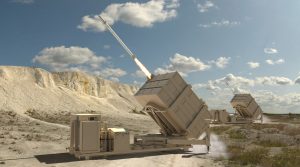The Army is seeking industry’s information on capabilities that could serve as a second interceptor solution for its new Indirect Fire Protection Capability (IFPC) Increment 2 defeat system, with a goal to have a technology demonstration around fiscal year 2025.
A new Request for Information (RFI) notice released on Jan. 12 details the Army’s interest in a second interceptor for IFPC Inc. 2 that would be capable of taking out supersonic cruise missiles and large caliber rockets.

“The new interceptor will utilize an open system architecture approach to establish lethal kinetic effects against select targets within the IFPC Inc 2 threat set, specifically supersonic cruise missiles and large caliber rockets. The new interceptor requires future capability growth with minimal levels of system redesign to address objective level threat sets,” the Army wrote in the new notice.
The Army previously awarded Leidos’ [LDOS] Dynetics a $237.4 million prototyping deal in September 2021 for IFPC Inc. 2, which aims to field a new ground-based mobile system capable of defeating cruise missile and drone threats (Defense Daily, Sept. 24 2021).
Dynetics’ Enduring Shield launcher capability beat out a team of Israel’s Rafael and Raytheon Technologies [RTX] offering a version of the Iron Dome system, with the Leidos-owned company tasked with delivering 16 launchers and 60 interceptors under the IFPC Inc. 2 prototype deal.
The current interceptor that is part of Dynetics’ Enduring Shield solution for IFPC Inc. 2 is Raytheon’s AIM-9X Sidewinder missile.
The Army has previously said IFPC Inc. 2 is “designed to defeat subsonic cruise missiles, Group 2/3 unmanned aircraft systems, rockets, artillery, mortars and other aerial threats,” while utilizing the Sentinel radar as its sensor, with the new Northrop Grumman [NOC]-developed Integrated Battle Command System serving as the fire control component.
Last week’s RFI notes the IFPC Inc. 2 product office is planning to integrate a second interceptor beginning in FY ‘25.
“When complete, the IFPC Inc 2 system will include tiered and layered effectors to provide 360 degree protection to fixed and semi-fixed sites,” the Army wrote in the notice.
For potential second interceptor solutions, the Army is also seeking details on interested vendors’ ability to conduct a technology demonstration between FY ‘25 and ‘26 “consisting of all digital simulation, hardware-in-the-loop, and/or live fire demonstration.”
The Army is also asking for industry’s input on whether their solutions currently exist or are developmental, information on a projected schedule for further design, testing and qualification and if any supply chain concerns could impact the potential program timeline.
The RFI also calls for a rough cost estimate for potential solutions if the Army plans to procure 8,000 interceptors over a 10-year production period.
Responses to the RFI are due back to the Army by Feb. 13.
The Army has previously said it plans to have a first operational battery of 12 IFPC Inc. 2 launchers available by late FY ‘23, with a decision on whether to move ahead on a production contract covering 400 launchers likely to be made this year as well (Defense Daily, Sept. 27 2021).